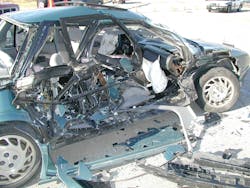University of Extrication: Jammed Door Skills Training
SUBJECT: Jammed Door Skills Training
TOPIC: Simulating late-model, lightweight-vehicle door construction
OBJECTIVE: Create a simulation of a jammed door on an older, acquired vehicle that represents the challenges presented by the plastic or lightweight materials and construction found on a modern vehicle
TASK: The vehicle rescue team shall open a simulated jammed door on an older, acquired vehicle that has been prepared to simulate the lightweight construction of a new model-year vehicle
One mission of a vehicle rescue instructor is to prepare rescue personnel for the realistic challenges that will be encountered at actual crash scenes. One of these frequently encountered challenges is dealing with a jammed door on a late-model vehicle. These new model car doors are increasingly found constructed with thin gauge metal materials or may even have a type of fiberglass or plastic outer door panel. At a crash scene, a lightweight door on a one- or two-year-old vehicle that is jammed can be significantly more difficult to force open compared to a door on an older vintage automobile. An older car’s door will most likely be all metal and will probably have a thicker gauge steel door panel.
The training issue, and the frustration felt by vehicle rescue instructors, is that we commonly only get 10- or even 15-year-old cars to tear apart. The same crew that only has access to older cars to train on may be called to extricate patients from a new, late-model car out in the real world. Unfortunately, our training on the old cars does not adequately prepare our personnel for the challenges of dealing with lightweight vehicle materials and new vehicle construction, especially when it comes to jammed doors.
So how does a team get experience opening a lightweight jammed door when the availability of newer cars with this style door might be very limited? The answer lies in some creative preparation of the door on an older model-year junk vehicle prior to the rescue team beginning their hands-on skills training session.
To simulate a jammed door on a late-model vehicle, one with thin metal door panels or possibly plastic panel materials, the instructor must first remove the skin of the door on the training car. Shut the door and lock it. Then begin door “skin’” removal. This can easily be done with an air chisel tool, for example. Cutting the skin off the door from hinge to latch side, top to bottom significantly weakens the door structure.
Once the skin is removed, the next task for the instructor involves cutting away the door collision beam. This component is designed to stiffen the door and in a crash, helps transfer collision energy away from and around the occupant compartment. By removing it prior to the start of the training session, the door is now even weaker.
Once the door on the old car is “skinned”, it is now time for the rescue personnel to practice opening a closed and locked door as if it were a jammed door on a new model car. To challenge the team even further, the assignment should be to require them to open the door at the latch side, not the hinge side. This is a tough scenario; one that will challenge the team as well as educate them on the reality of how new vehicle doors might react at a crash scene.
TASK: The vehicle rescue team shall open a simulated jammed door on an older, acquired vehicle that has been prepared to simulate the lightweight construction of a new model-year vehicle
